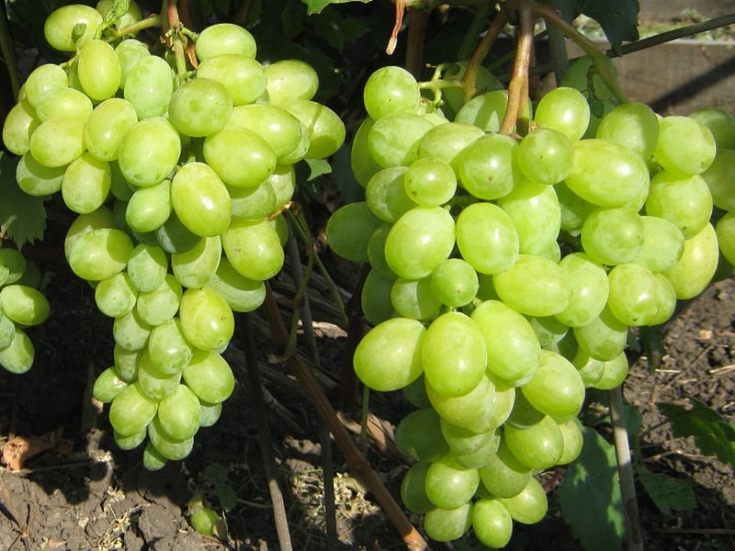
Grapes Timur - one of the earliest ripe table varieties. Summer residents choose it for large clusters and unusually tasty berries. Meanwhile, growing grapes can cause difficulties for the beginning gardener: he is demanding on a balanced soil composition, nutrients and pruning.
Content
general description
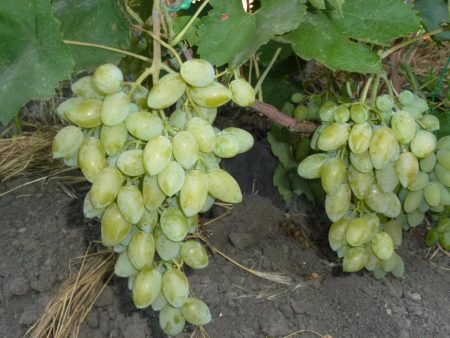
Timur is the brainchild of Russian breeders. It was bred on the basis of two wonderful varieties - Delight and Frumoas Albe. These two varieties have extraordinary characteristics: they are early ripe, have a high immunity to diseases, and tolerate adverse weather conditions. Timur is endowed with all these qualities. In addition, the list of its positive qualities is complemented by an excellent presentation of grapes and a bright balanced taste of berries. Thanks to its positive qualities, Timur grapes are successfully cultivated in almost all regions of the country. In the southern region, he is raised as a non-covering culture. Experts note that in central Russia, as well as in the North, it is better to cover the plant for the winter.
Biological features
Timur grapes have early ripening. The first berries reach biological maturity by the 115th day from planting. Harvest usually begin to harvest at the end of July. The plant enters the fruiting phase in the third year after planting.
The grape bush itself has an average growth rate. Its height barely reaches two meters. In this case, the vines grow slowly, although they ripen in time. Newborn shoots have a light green color. By the end of summer, the whips become woody, the bark becomes dark brown.
Despite the rather modest size, Timur grapes are demanding for a large space. If other shrubs grow nearby, it will greatly lag behind in growth.
In the warm season, shoots are overgrown with thick large three-lobed, carved foliage, which gives the bush a beautiful appearance. The decorativeness of the plant allows you to use this variety not only to obtain edible berries, but also in order to decorate the garden interior - arches, arbors and fences.
Growing in a temperate climate, in conditions of balanced humidity and air temperature, the plant gives a good yield. Variety testers note that 75% of all shoots on the bushes are fruitful. And even on perennial wood, shoots are able to form a decent cluster size. On each separate branch 3 voluminous, densely packed clusters ripen, the average mass of which reaches 600-700 grams. The berries themselves are large, elongated, weighing 6-7 grams. They gather in narrower brush-cylinders. The peel of the fruit is thin, but dense, it is barely noticeable when bitten. Its color is golden green. The pulp is juicy, friable, moderately watery. Taste on a 5-point scale is rated at 4.8. Those who have tasted Timur grapes claim that it is a very sweet variety with a distinct flavor of nutmeg. The sugar content in the pulp is 25%, while there is practically no acid. Thanks to the dense skin, ripe berries do not burst during transportation and are stored for a long time.
The variety shows high productivity only if it is planted correctly and properly maintained.
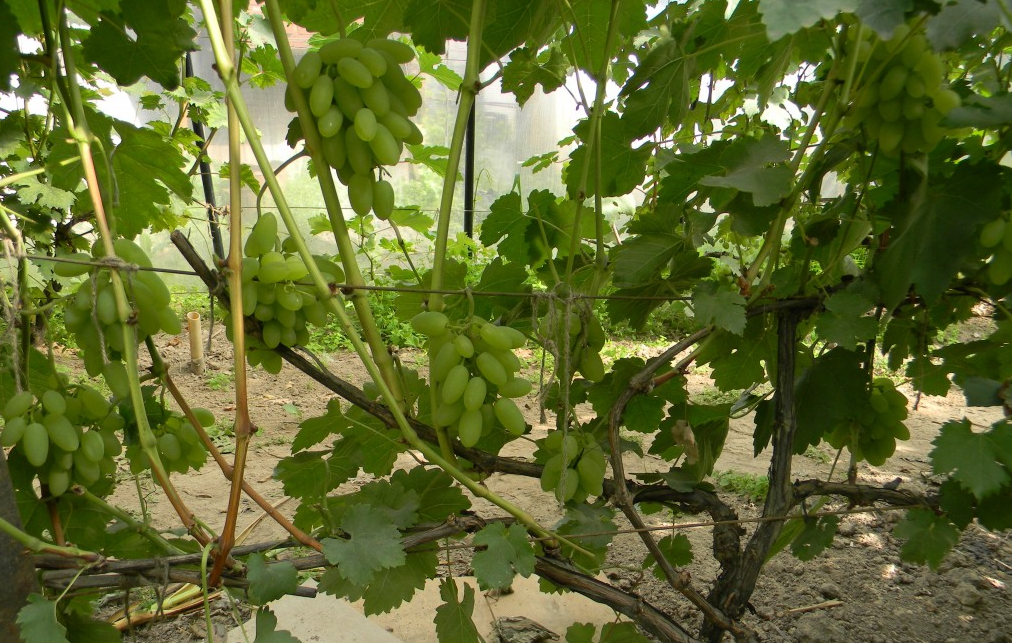
A characteristic feature of Timur grapes is the high survival rate of seedlings. The rooting of cuttings usually takes place without interference. Moreover, grapes can be easily propagated by grafting and layering.
Stable productivity is affected by the fact that the flowers are bisexual, that is, they do not need pollinators. Subsequently, the flowers are replaced by large dense berries of the same size ("pea" almost never occurs).
Timur has an enviable health. The plant is rarely affected by mildew and gray rot. The only one who can spoil the appearance of the bushes is a grape tick. Getting rid of him is not easy. Therefore, it is necessary to regularly treat the bushes with insecticides such as Vertimek or BI-58. At the beginning of the season, it is also possible to use the oil-mineral agent ZOV, which fights against the main types of pests.
The sweet aroma of berries attracts wasps that spoil the fruits. You can save the crop by hanging the bushes with a net or by setting sweet traps away from the vineyard.
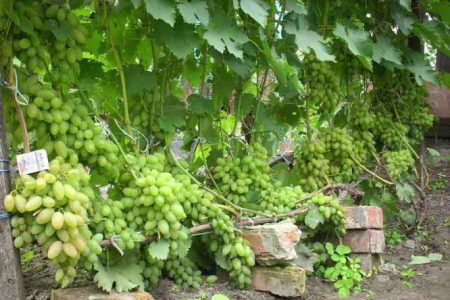
Although the plant’s standard is highly frost-resistant (it can tolerate frosts down to -25 degrees), vines and buds often get frostbite if they are left without shelter in winter. Therefore, experienced growers are advised to shelter the vine bush during the cold weather. Shelter is required not only for young seedlings, but also for fruit-bearing bushes.
Despite all the “merits”, Timur demands from his owner maximum attention to his person, otherwise he simply will not grow and give a harvest. Even those bushes that have been planted as decorative targets need constant top dressing, pruning and shelter. Frequent timely watering is also important. And to increase productivity, gardeners resort to tricks: they plant Timur on the old roots of a taller and healthier relative. Thanks to this method, you can get a very promising grape bush, which will give at least twice as much crop as a root plant.
Timur is a table variety. That is, it is better to use it fresh, although it produces excellent raisins, delicious compotes and good white wine.
Advantages and disadvantages
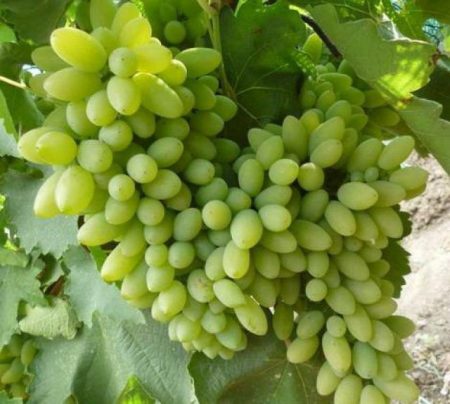
Varietal grapes have a lot of advantages. Among them:
- early ripening of fruits;
- very good taste of berries;
- high resistance to diseases;
- excellent marketability of grapes;
- high productivity in comparison with stunted bush;
- the possibility of cultivation in different regions of the country.
Along with the advantages, Timur is also “endowed” with disadvantages, which, with proper agricultural technology, are insignificant. The main disadvantages of the variety are:
- the modest size of the bush, which does not allow to increase productivity;
- exactingness of a plant to a specific soil composition;
- the need for shelter for the winter.
Another Timur
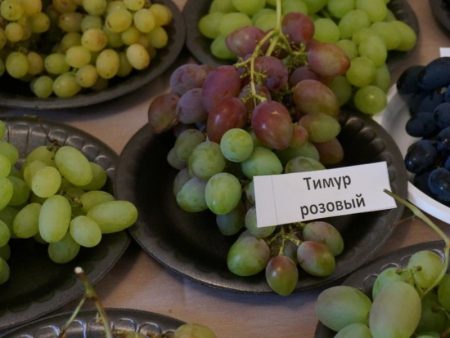
Ordinary White Timur has a half brother - Pink Timur. A variety is obtained that produces pink fruits by crossing the common Timur and the Kuban Delight. This young variety is quite widespread in Russia, although White Timur is clearly superior to the Pink Brother in popularity.
Salient features of Pink Timur:
- clusters are more voluminous than that of the White species. Their mass often reaches 900 grams;
- the berries themselves are elongated, very large;
- high sugar concentration makes berries more high-calorie;
- the peel is very dense, although it does not interfere with the berries;
- 40-50 berries are collected in loose brushes;
- the plant is often affected by a tick.
Grape growers claim that it is precisely because of poor immunity that Pink Timur is not as popular as its White predecessor. In addition, the pink variety is not so productive - its yield is below average.
Growing Features
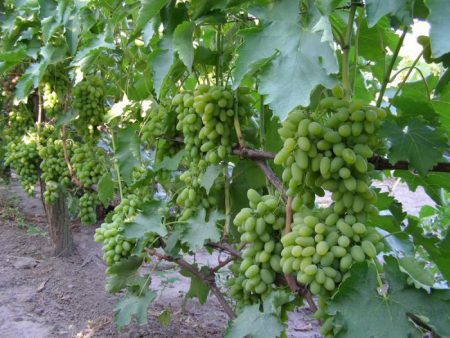
It is recommended to break the vineyard in a well-lit area, away from the cold northerly winds.It is best if this crop grows on fertile loam with low groundwater flow. On moist and dense alkaline soils, Timur gives sour berries with a tart hard peel. The soil should be loose, nutritious, with good aeration and water permeability.
Planting of grapes is carried out by rooted seedlings. Healthy, productive young bushes should have 2-3 thick strong shoots. Each of them should have at least 3 kidneys. If Timur is already growing in the garden, then propagating it is quite simple with the help of grafting: one-year-old cuttings are “planted” to the roots of other more tall and strong varieties. Vaccination avoids the main problem - exactingness to the soil. The grafted Timur is not so capricious and also gives much more developed fruit shoots, which in turn form a magnificent crop.
The grafted grapes will begin to bear fruit a little later, only on the 125th day of the growing season. However, it will still be considered early ripening.
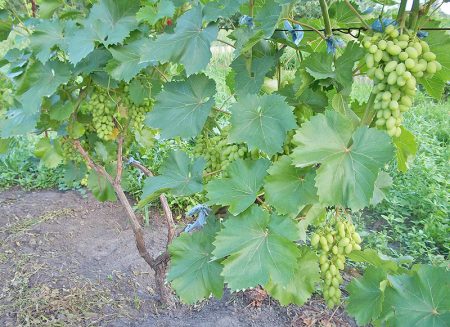
It is customary to plant root plants in the fall, in mid-September, while vaccination is more rational in the spring. The ideal time is early spring, when the plants have not yet woken up completely and sap flow has not begun.
Wells for grape seedlings are arranged in a distance from tall trees and shrubs and buildings. The interval between them should be at least 3 meters. The distance between the grape bushes is 1-1.5 meters. Aisle should be 2 meters.
Vineyard care
To grow a well-bearing developed fruit grape varieties Timur, frankly, is not easy. He needs regular watering, tillage, frequent but careful pruning, shelter for the winter, and top dressing. All these agrotechnical methods cannot be neglected, otherwise the bush will simply stop growing.
Watering
Watering grapes should be infrequent, but plentiful. It is important that the soil is moistened to a depth of 80 centimeters. In spring and autumn, water the plants twice, in the summer - more often. In dry periods, additional irrigation is arranged. If the plant lacks moisture, then the berries can form small and not so sweet.
Tillage
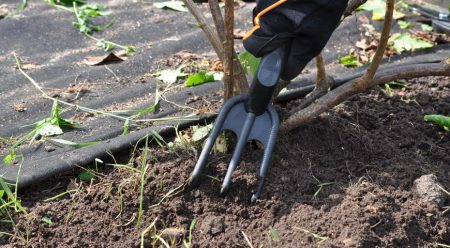
The plot on which the grapes grow should be completely cleared of weed, which always negatively affects the growth of the crop. After watering, in order to avoid the appearance of earth crust, the surface is loosened. Loosening under young bushes is done shallow, under fruiting - to a depth of 20 centimeters. So that the moisture does not evaporate so quickly, the area under the plant is mulched with humus, moss or sawdust. You can also use herbal compost - it will not only serve as a protection against evaporation, but also inhibit the growth of weed and at the same time nourish the roots of the grapes with necessary trace elements.
Pruning
In the first year only formative pruning is performed, then sanitary and anti-aging pruning is also arranged. The formation takes place on the basis of two or three main shoots, which are cut for lashes. Young growth, damaged branches affected by the disease and pests are annually cleaned. Also remove the barren and old branches and those that have already bred. Up to 5 shoots of fruiting and 6 shoots of substitution must always be on the bush at the same time. Each shoot must have up to 20 eyes. If you leave more, then the clusters will not form so large. It is important that all shoots have the same number of buds.
Top dressing
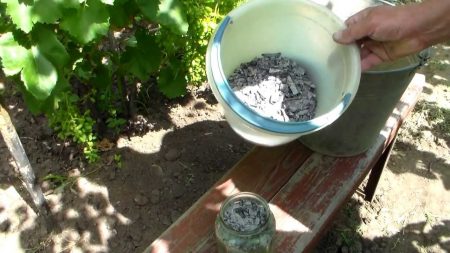
If seedlings were planted on fertile soil, generously fertilized with organic and minerals, then this year additional fertilizer application is not required. Otherwise, when planting seedlings, humus, superphosphate and potassium chloride are added to the hole. Ash is also added. In the spring, nitrogen-containing fertilizers (urea) are applied under the bushes. In summer, during flowering, the plant needs superphosphate.In autumn, the bushes are fed with potassium, so that they better winter.
Harvesting and storage
Harvest grapes begin in the last days of summer. In ripe form, the berries are painted in golden color with a reddened barrel. They hang on a long sturdy stalk. In ripened form, they hold out on the bush for a relatively long time (a couple of weeks), becoming even sweeter. Already harvested grapes are kept in a dark place. The grapes can be stored in the refrigerator for up to 12 days.
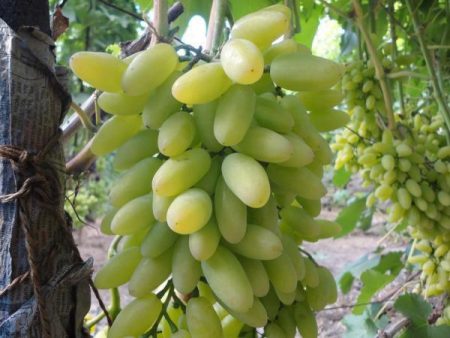
Reviews
Sergey
A good variety, however, I would not advise beginners to begin to comprehend the basics of viticulture with this particular variety. It grows well only when it is comfortable. The slightest deviation in temperature, humidity, balance of fertilizers, unfortunately, will immediately lead to inhibition of the plant. Well, if you are fully equipped, constantly take care of the grapes, then even in the second summer you can taste delicious and sweet berries for the first time. In fact, their taste is so extraordinary that even because of this, you can endure all the difficulties of growing Timur. I also tried another such unusually delicious grape.
Catherine
Several years ago, Timur grapes were grown. I liked it because the seedlings quickly took root, went to growth. The adult bush reached a height of 180 centimeters. For the first time, good yield was shown only in the fourth year, although the first grapes appeared in the second and third years of life. True, their taste was not so juicy, and in size they were not large. In the fifth year, winter was frosty, and our grapes were completely frozen out, although it was under cover. Honestly, I was dumbfounded by this outcome. In general, he showed productivity only once. In general, Timur is a good variety that requires certain knowledge and skills. Yes, it is whimsical to the growing conditions, but it does not cause too much trouble. I am inclined to buy new seedlings of this variety. Let's see what happens.
Timur is an unconventional table variety that surprises, first of all, with the appearance of the berries and their sweet taste. This grape, like the vast majority of other varieties and hybrids, is not without flaws, but they are easily compensated by the mass of positive qualities that Timur is endowed with. Difficulties in growing the plant can be avoided if you pay special attention to soil fertility and the amount of moisture even when laying the vineyard.




 Non-covering winter-hardy grape varieties for Moscow region
Non-covering winter-hardy grape varieties for Moscow region How to keep the vine in winter
How to keep the vine in winter When can I transfer grapes to another place in the fall
When can I transfer grapes to another place in the fall How to cover and prepare grapes for the winter in the suburbs
How to cover and prepare grapes for the winter in the suburbs